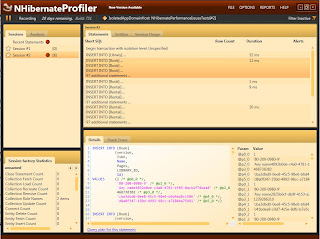Why I'm taking about previous stuff? The are a lot of articles how the original NHibernate's purpose isn't to support batch operations, like inserts. Once you have decided to NHibernate, you have to solve this issue.
Slow insertion
The basic way how to insert mapped entity into database is:
SessionFactory.GetCurrentSession().Save(object);But what happen when I try to insert many entities? Lets say, I want to persist
- 1000 libraries
- each library has 100 books = 100k of books
- each book has 5 rentals - there are 500k of rentals
Each SQL insert is sent to server within own server request.
Batch processing with using adonet.batch_size
You can set property adonet.batch_size within your hibernate configuration to tell NHibernate that he can sent more queries to the SQL server within one statement. I'm going to set this value to 100. What's the improvement? Insertion took 171 seconds right now. Better than 276! But isn't it a lot of time? Yes it is!
The major problem is that NHibernate standard insertion via Session.Save is not intended to use for batch processing. NHibernate generated events, go through mapping, doesn't group insert statements together in proper way by default. Obviously, it must take some time. Now, it's the time to introduce ...
Stateless session
NHibernate's developers are smart guys so this significant functionality can't stay in "not-intended for batch processing" state. Stateless session is tool intended for batch processing.
Stateless session is lightweight version of Session.Save method, it doesn't throw so much events, it's fast, it just generates one insert for given object according to mapping. It's fast, so it apparently has any drawbacks.
Stateless session's drawbacks
- stateless session isn't compatible with standard NHibernate session! There is another interface because it has completely different purpose. Spring.net's support is missing, you can't use transaction template. You must handl all the stuff by yourself.
- because of intended fast behavior, stateless session doesn't handle any cascade operation on children. You must manually push all objects to session, all children, their children, etc.
Despite I've set adonet.batch_size to 100, only 5 inserts are sent to SQL server within one statement. NHibernate groups inserts only for same type of entity. You aren't able to achieve optimized query count with using standard way.
As I've said, you must call Insert method for each entity, so you can group all inserts of each specific entity by your code. Here are results of insertion:
- 149 seconds - no advanced grouping when inserts are sent to sql server - insertion of first library followed by insertion of it's books, insertion of all book's rentals, insertion of another library - we aren't still use fully utilized power of adonet.batch_size because only 5 inserts are sent in one statement
foreach (Library library in libraries) {
session.Insert(library);
foreach (Book book in library.Books) {
session.Insert(book);
foreach (Rental rental in book.Rentals) {
session.Insert(rental);
}
}
}
- 86 seconds - first of all libraries are processed by session's insert following by all books and all rentals - this approach efficiently uses batch size, because for 100k of books it sents only 1000 statements to SQL server, each having 100 of insert followed by set of 5k of inserts statements for rentals
foreach (Library library in libraries) {
session.Insert(library);
}
foreach (Library library in libraries) {
foreach (Book book in library.Books) {
session.Insert(book);
}
}
foreach (Library library in libraries) {
foreach (Book book in library.Books) {
foreach (Rental rental in book.Rentals) {
session.Insert(rental);
}
}
}
- 80 seconds - adonet.batch_size = 1000
Stateless session is efficient!
The best result is the small summary of measured times because the main benefit of stateless session will exactly appear. The example persists (1k + 100k + 500k) 601k of entities.
| session type | adonet.batch_size | additional groupping | time [s] |
| standard | no | no | 276 |
| standard | 100 | no | 171 |
| stateless session | 100 | no | 149 |
| stateless session | 100 | yes | 86 |
| stateless session | 1000 | yes | 80 |
If you need to improve your application's insertion time, just use stateless session.
You can also see Series of .NET NHibernate performance issues to read all series articles.



7 comments:
Great post i must say and thanks for the information. Education is definitely a sticky subject. However, is still among the leading topics of our time.
I appreciate your post and look forward to more.
Reactjs Training in Chennai |
Best Reactjs Training Institute in Chennai |
Reactjs course in Chennai
I'm really impressed with your writing skills, as smart as the structure of your weblog.
GoLand Full Crack
Waves v12 Complete Crack
Also allow the use of 3D graphics though very incomplete. One more interesting characteristic that was introduce is accessible for afterward version is the Marketplace. Game Maker Studio Free Download
Get intelligent suggestions in the Editor Overview pane in Word and let Editor assist you across documents, email, and on the web Microsoft Office 2016 Product key Generator
Thursday is my favorite day to plan how I’m going to get out of the plans I already made for the weekend. Thursday Quotes
Great work! I appreciate your work.
https://thepcsoft.com/boxcryptor/
Thhanks great post
Post a Comment